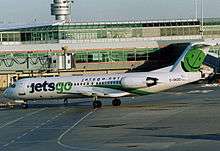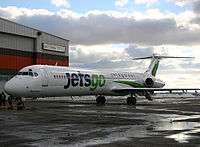Jetsgo
Jetsgo Corporation was a Canadian low-cost carrier based in the Saint-Laurent borough of Montreal.[1] Jetsgo served 19 destinations across Canada, 10 destinations in the United States, and 12 scheduled weekend-charter destinations in the Caribbean. At the time the third-largest carrier in the country, Jetsgo abruptly ended service and entered bankruptcy protection on March 11, 2005, leaving thousands of passengers stranded at the beginning of the busy March-break travel season. According to news outlets, the airline was processing orders and taking payments for flights the night before they claimed bankruptcy and ceased operations.[2]
 | |||||||
| |||||||
| Founded | 2002 | ||||||
|---|---|---|---|---|---|---|---|
| Ceased operations | 2005 | ||||||
| Hubs | Montréal-Pierre Elliott Trudeau International Airport Toronto Pearson International Airport | ||||||
| Frequent-flyer program | JetSmiles | ||||||
| Fleet size | 29 | ||||||
| Destinations | 41 | ||||||
| Headquarters | Montreal, Quebec | ||||||
| Key people | Michel Leblanc (CEO) | ||||||
| Website | Jetsgo.net | ||||||
Soon after its demise, the company pledged to make a comeback as a charter-only airline. However, on May 13, 2005, the airline filed for bankruptcy protection, cancelled plans to relaunch service and began the process of liquidation.
History

Jetsgo was launched on June 12, 2002, and ceased operations on March 11, 2005. The airline was Canada's third-largest airline at the time, controlling up to 10% of the domestic market. Expert analysts widely blame the airline for poor management. Founder Michel Leblanc had previously founded Royal Aviation, which he later sold to Canada 3000.
On March 11, 2005, Jetsgo abruptly announced that it had ceased operations. The action stranded thousands of passengers in airports and at their travel destinations with no way home, the defunct airline having made no arrangements with other carriers to handle their passengers. This occurred on the Friday morning before the March Break holiday season, one of the busiest air travel days in 8 of 10 provinces.
1200 employees lost their jobs. Jetsgo had accumulated $55 million in debt in the last eight months before it closed. Employees were finally paid for the time prior to the airline's shutdown on March 14, 2005. Passengers who had purchased Jetsgo tickets were forced to apply for refunds through their credit card companies or travel agencies. Air Canada and WestJet ran additional flights to bring the stranded passengers home.
Because of its abrupt shutdown, the Jetsgo name was frequently corrupted to "Jetsgone" in some media reports. Passenger Satoshi Takano also used this term for a website[3] which he created for former employees. It operated under that name for some time after the company's demise.
In February 2007 the media reported that the United States military was using the former call sign assigned to Jetsgo during flights over European Union (EU) territory. The Sunday Times said that the call sign had been used by military flights involving so-called "extraordinary rendition" of political detainees to black site destinations.[4]
Staff
The airline employed 1,350 people at the time that it filed for bankruptcy.[5]
Incidents and accidents
In March 2005 Transport Canada said that investigators found issues with the operating methods of Jetsgo. The deficiencies were discovered during "a special inspection" into engine problems revealed after a forced landing in Toronto in January 2005.

The number of incidents reported per year about Jetsgo:[6]
- 2002: 5
- 2003: 15
- 2004: 32
- 2005: 7
- Total (2002–2005): 60
On 20 January 2005 a Jetsgo McDonnell Douglas MD-83 landing in poor weather and low visibility at Calgary International Airport, in Calgary, Alberta, veered left off runway 34 and hit a runway hold-short sign, damaging landing gear and flaps. The plane then declared a missed approach, took off and landed again. There were no casualties.[7][6]
Destinations
Canada
- Alberta
- British Columbia
- Manitoba
- Newfoundland
- Nova Scotia
- New Brunswick
- Moncton
- Saint John
- Prince Edward Island
- Ontario
- Ottawa
- Thunder Bay
- Toronto
- Timmins
- Quebec
- Montreal
- Quebec City
- Saskatchewan
United States
- Los Angeles, California
- Florida
- Fort Lauderdale
- Fort Myers
- Sanford (Orlando)
- Sarasota/Bradenton
- St. Petersburg
- West Palm Beach
- Las Vegas, Nevada
- Metropolitan New York City
Charter operations
Jetsgo also operated weekend scheduled charter services from Toronto and Montreal to destinations in Cuba, the Dominican Republic and Mexico.
Fleet

Jetsgo operated a fleet of 14 McDonnell Douglas MD-83 and 11 Fokker 100 (plus six Fokker 100 in storage);[8] three more Fokker 100s were due for delivery in 2005. Seating in all aircraft was configured in an "all-economy" setting typical of low-cost carriers. Jetsgo also had special "comfort plus" sections on most of their planes, which featured more leg room on seats A and B in rows 1 - 12, as well as no middle seat.
Slogan
- "Jetsgo. Pay a little. Fly a lot." /"Jetsgo. Moins cher, plus souvent."
See also
References
- "Talk to Us." Jetsgo. Retrieved on June 5, 2009.
- CBC's follow-up to Jetsgo's closure - cbc.ca
- "US military planes criss-cross Europe using bogus call sign", The Sunday Times, 19 February 2006
- "Spring-break shock; Cheap fares and no-frills service marked the brief history of Jetsgo Corp., which went out of business yesterday". Toronto Star. 2005-03-12. p. F1.
- "Safety issues dogged Jetsgo; One jet involved in eight 'incidents' In January, a plane veered off runway". Toronto Star. 2005-03-17. p. C1.
- Flight International, July 2005
- "Canadian discount airline Jetsgo". Air Transport World. April 2005. Cite journal requires
|journal=(help)
External links
| Wikimedia Commons has media related to Jetsgo. |